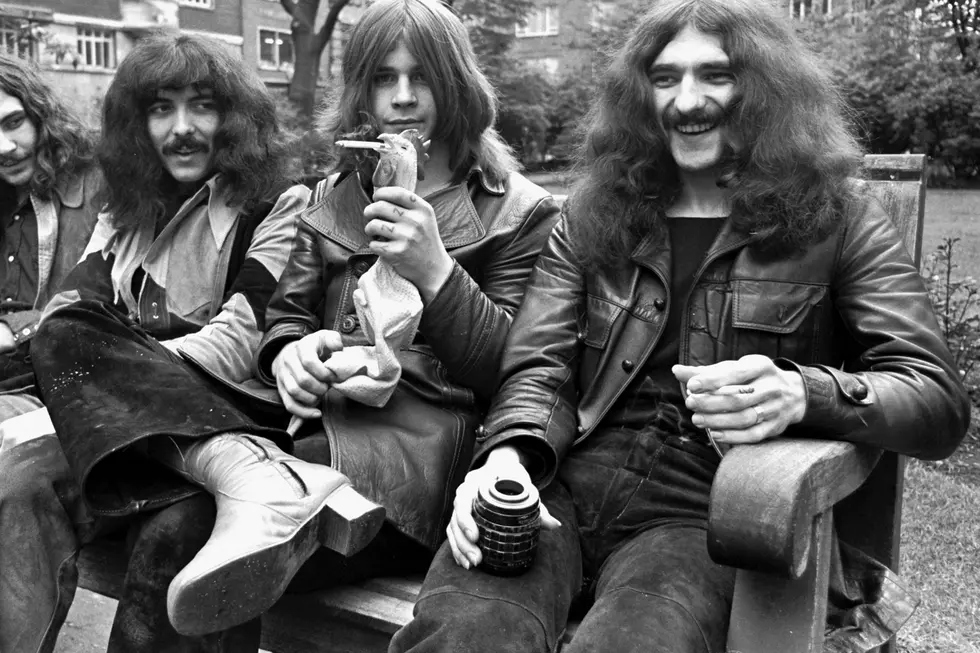
1970: The Year Heavy Metal Was Born
Tolling church bells and pouring rain are sounds typically associated with funerals. They also marked the birth of heavy metal, after being used as the introduction to Black Sabbath’s eponymous 1970 debut.
But did Black Sabbath really invent heavy metal?
Well, obviously not all by themselves, and not right away. Years would pass before the “heavy metal” description actually stuck with listeners, or was even accepted by many of the bands involved. But most of the genre’s fundamental musical ingredients, lyric themes, and even its outcast status as rock and roll’s bastard offspring, were crystallized on Sabbath's first album.
Prior to 1970 and Black Sabbath's arrival, the sounds that we now recognize as the building blocks for heavy metal were both scattered and accidental, making it impossible to pinpoint any other album or band as the genre's absolute Ground Zero. From the start of the British Invasion came the Who (Live at Leeds was, coincidentally, recorded the day after Sabbath's debut was released), the Yardbirds and the Kinks, all of whom were incorporating distortion and feedback into their records as far back as the mid-'60s.
Metal's roots in heavy blues came from Cream, the Jeff Beck Group, Iron Butterfly, Vanilla Fudge and, of course, Jimi Hendrix and Led Zeppelin. Add to that group Steppenwolf, who are credited with coining the phrase "heavy metal" in "Born to Be Wild." Together, these acts proved that this sound was, in fact, commercially viable.
Perhaps the only group that came close to capturing heavy metal’s fatalistic outlook, sheer volume, and anti-social nature prior to 1970 was San Francisco’s Blue Cheer on 1968's thunderous Vincebus Eruptum. And yet, not even they hit the heavy metal bulls-eye.
At the same time, one should never underestimate the importance of the period’s improving amplification technology, led by the newly developed Marshall stack.
That brings us back to 1970, and Black Sabbath's paradigm-shifting first album. Within months, record stores across the globe would be infiltrated by dozens of releases that are seen today as cornerstones of heavy metal, delivered by bands that both predated Sabbath and followed in their wake.
Listen to Led Zeppelin's 'Whole Lotta Love'
Chief among the former category, perhaps, were Deep Purple, which had already produced three studio albums. They scored a major U.S. hit with “Hush” in 1968, and then dabbled in symphonic rock with 1969's Concerto for Group and Orchestra, only to reinvent themselves behind the incomparable guitar virtuosity of leader Ritchie Blackmore for 1970’s pivotal In Rock. Deep Purple would complete the holy trinity of British heavy rock, along with Black Sabbath and Led Zeppelin – who, ironically, turned to folkier sounds with their third LP in 1970, though not before unleashing the driving Viking metal opener “Immigrant Song.”
Other late-‘60s Brit contenders seeking to capitalize on this hot new musical style included Steve Marriott’s always-fiery Humble Pie (see “One-Eyed Trouser-Snake Rhumba”), Roy Wood’s post-psych, pre-prog ensemble the Move (“Brontosaurus”), and more adventurous blues outfits like Peter Green’s Fleetwood Mac (“The Green Manalishi”), Rory Gallagher’s Taste (“What’s Going On”), Tony McPhee’s Groundhogs (“Strange Town”) and Free, via the spartan power chords of “All Right Now.” Why, even rock chameleon-in-waiting David Bowie let his budding guitar hero Mick Ronson go berserk on 1970’s The Man Who Sold the World (witness “She Shook Me Cold”), a proto-metal classic by most any definition.
Furthermore, numerous groups straddled the still-fine line between heavy metal and progressive rock that year, including Ian Anderson’s indefinable Jethro Tull (“Alive and Well and Living In”), the twin-guitar fueled Wishbone Ash (“Lady Whiskey”), the John Du Cann-led Atomic Rooster (“Death Walks Behind You”), and the oft-overlooked Stray (“All in Your Mind”) and May Blitz (“Smoking My Day Away”).
Then there were promising rookie bands, like future Deep Purple member Glenn Hughes' fast-burning Trapeze (Medusa) and perhaps the fourth most important British metal band during those early years, Uriah Heep. Founded midway through 1970 by chief songwriter, keyboardist and guitarist Ken Hensley after his departure from the improbably named Toe Fat (see “That’s My Love for You”), Uriah Heep would spend many years nipping at the heels of Black Sabbath, Deep Purple and Led Zeppelin with formidable LPs and classic songs like “Gypsy” and “Bird of Prey.”
Listen to David Bowie's 'She Shook Me Cold'
Meanwhile, in America, heavy metal took on just as many forms over the course of 1970. Here too, there were numerous holdovers from the ‘60s taking their best shot at the changing musical currents, including power trios like Leslie West’s Mountain (“Mississippi Queen”), Joe Walsh’s James Gang (“The Bomber”) and Grand Funk Railroad. The ultimate people’s band, Grand Funk churned out one of the year’s absolute heaviest riffs on “Sin’s a Good Man’s Brother.”
Another faction was comprised of bands that were still transitioning between late ‘60s psychedelia and early ‘70s art rock, such as Detroit acid-cases Power of Zeus (“It Could be Me”) and Frijid Pink (“I Want to be Your Lover”), Texan combos Bloodrock (“D.O.A.”) and Josefus (“Dead Man”), not to mention far more obscure outfits like Minnesota’s Lightning (“Prelude to Opus IV”) and New Jersey’s Sainte Anthony’s Fyre (“Love Over Me”).
Meanwhile, the quasi-supergroup Cactus (check out the insanely heavy “Let Me Swim”) had assembled around the erstwhile Vanilla Fudge rhythm section of Tim Bogert and Carmine Appice, and, perhaps more than any other band, exemplified the older generation’s efforts to stay relevant. On the other hand, no U.S.-bred group represented the next generation better than Sir Lord Baltimore. Once criminally obscure, now widely championed, these Brooklyn-based rockers probably delivered the first genuine American heavy metal album in 1970’s seminal Kingdom Come, boasting retroactively worshiped rave-ups like “Master Heartache,” “Lady of Fire” and the doom-laden title track.
Here's how pervasive heavy metal became within the span of one short year: Even Billy Joel made an ill-advised but mercifully brief foray into the genre by way of the widely maligned Attila (see “Wonder Woman”), where he ran his Hammond organ through a Marshall stack.
Listen to Black Sabbath's 'Paranoid'
From Canada came the precocious Warpig (“Melody With Balls”). Germany gave us the eclectic Jeronimo (“Highjack”), the Krautrock-leaning Nosferatu (“Highway”) and the as-yet-unsigned Scorpions. Scandinavia had Norway's Titanic (“Searchin’”), Sweden's November (“Mount Everest”) and Denmark's eccentric Pan (“If”) and the misleadingly named Blues Addicts (“Hailow”). Japan produced the fabulously named Flower Travellin’ Band, which covered “Black Sabbath” on 1970’s Anywhere LP, before developing their own heavy and eccentric material in years to come.
There were scores more, as underground heavy rock bands sprung up everywhere – including acts with curious monikers like Aardvark, Pax, Lyd, the Damnation of Adam Blessing, and Bulbous Creation. By then, however, Black Sabbath had released their second LP of 1970, Paranoid. Its cornerstone classics like “War Pigs,” “Iron Man” and the frenzied title track consolidated heavy metal’s definitive musical blueprint, while proving the group’s revolutionary vision was no fluke.
Instead, the flood gates had been opened. In addition to follow-ups from Black Sabbath, Deep Purple, Uriah Heep and others, 1971 then saw the emergence of key new groups like Budgie, Dust, Bang, Nazareth, Thin Lizzy, Pink Fairies and Leaf Hound even as future Motorhead icon Lemmy hooked up with space rockers Hawkwind. By 1972, Blue Oyster Cult had arrived, followed by Montrose, Aerosmith and others in 1973, and then Judas Priest in 1974.
But it can all be traced back to 1970: the year heavy metal was born.
See the Top 50 Heavy Metal Albums of All Time
You Think You Know Black Sabbath?
More From Ultimate Classic Rock









